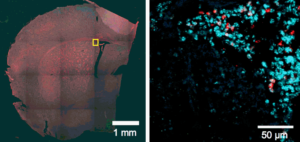
Calcium isn’t just for bones and teeth. It also has an important job in the brain, delivering signals to help neural stem cells function. But until now, scientists didn’t know how calcium got into these cells.
Murali Prakriya, PhD, associate professor in Pharmacology, and his lab identified the channel that brings calcium into cells to control neurogenesis, a carefully choreographed brain process in which neural stem cells replicate and become neurons. Those neurons go on to play vital roles in memory, learning and recovery following brain injury.
[pullquote]“Knowing the mechanisms that control proliferation of neural stem cells can help us understand how we might apply stem cell based therapies for conditions like stroke and neurodegenerative diseases down the road,” said Prakriya. “Now that we know how calcium enters neural stem cells, we can target and manipulate that pathway to regulate the functions of calcium signaling in these cells.”[/pullquote]
Graduate students Agila Somasundaram, ’14 PhD, in the Northwestern University Interdepartmental Neuroscience Program, and Andrew Shum, in the Driskill Graduate Program in Life Sciences, carried out the experiments.
Using neural stem cells of embryonic and adult mice, the scientists identified a pathway called the calcium release-activated calcium (CRAC) channel. It consists of two proteins: Orai1, which permits calcium to enter the cells, and STIM1, which activates the calcium once it’s inside.
Scientists already knew that the CRAC channel – the pair of proteins working together – existed elsewhere in the body: it sends calcium into the immune system to activate immune cells exposed to pathogens.

This study, published in the Journal of Neuroscience, made two new important discoveries.
“First we found that CRAC channels constitute the major route of calcium entry in neural stem cells,” said Prakriya. “Second, we determined that the calcium that comes in through CRAC channels regulates proliferation of neural stem cells.”
There are many potential translational implications of this work.
For instance, scientists can use it to understand how mutations in the CRAC channel affect patients’ cognitive abilities. In addition, suppressing CRAC channel activation might be a way to control brain tumor formation that is caused by runaway cell proliferation.
Immune disease treatments aimed at the CRAC channel also need to consider the channel’s function in the brain.
“Antagonism of CRAC channels might suppress the immune system, but it might not be so great for neurogenesis,” said Prakriya. “Historically, most of the information known about CRAC channels has been for the immune system. Now we have a flip side.”
Prakriya’s lab is currently following up on these findings to see how the two CRAC channel proteins regulate the brain’s recovery after a stroke.
This study was supported by the National Institutes of Health grants NS057499 and AI097302 and the Brain Research Foundation.






